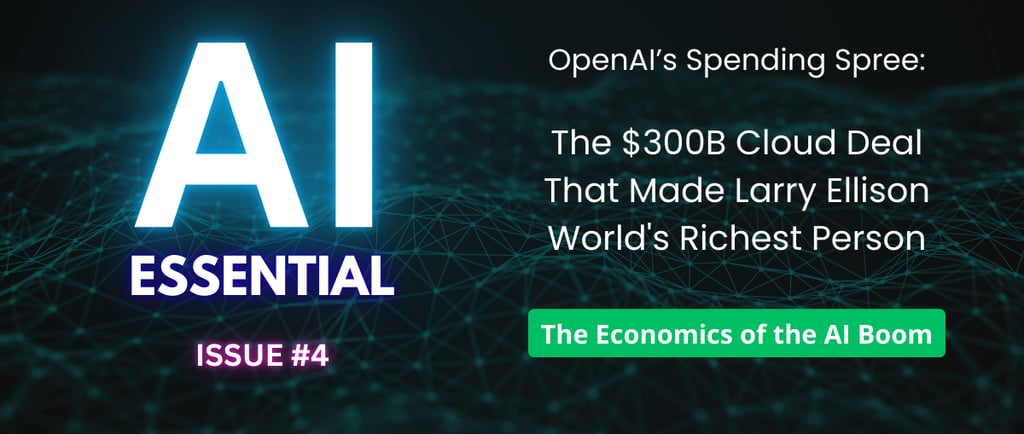OpenAI’s $300B Cloud Deal That Made Larry Ellison the World's Richest Person
This week's article explores what OpenAI's spending spree reveals about the true economics — and risks — of the AI boom.
AI ESSENTIAL
Eric Wabrick
9/15/20252 min read


AI Story of the Week
Last week, Oracle’s stock surged 30%+ after announcing what may be the largest cloud contract in history: a $300 billion, multi-year deal with OpenAI starting in 2027.
The deal, tied to OpenAI’s “Project Stargate,” will require 4.5 gigawatts of new power capacity — roughly the output of four nuclear power plants — and massive new data center buildouts.
The market’s reaction was immediate. Oracle’s surge briefly added ~$100 billion to Larry Ellison’s net worth, making him the richest person in the world.
But behind the market euphoria lies a harder question: can OpenAI — still operating under a nonprofit structure and running far ahead of its revenues — actually sustain this level of spend?
Key Insights
1. Infrastructure is the real winner of the AI race.
Model debates grab headlines, but the profits are flowing to the companies selling the picks and shovels. Nvidia (chips), Microsoft (cloud), Broadcom (custom silicon), and now Oracle (data centers) have collectively added $4.5 trillion in market cap since ChatGPT’s launch.
2. The power requirements are staggering — and constraining.
4.5 gigawatts isn’t just a technical stat; it’s an energy story. Scaling frontier AI now means negotiating with utilities, regulators, and governments. Access to reliable power could matter as much as access to GPUs.
3. Backlog ≠ guaranteed revenue.
Oracle reported $455 billion in remaining obligations, up 359% year-over-year — but most of that is concentrated in one customer. While OpenAI has shown impressive growth with ChatGPT and enterprise adoption, generating the tens of billions annually required to service these contracts is a different challenge entirely.
4. The ecosystem is dangerously concentrated.
A handful of infrastructure providers are capturing nearly all the value. That concentration creates opportunity for incumbents — but systemic risk for the broader economy if even one of these players stumbles.
Why It Matters & How to Apply It
This deal is more than a stock pop — it’s a window into where the value in AI is actually flowing. The economics of the boom are tilting toward infrastructure: chips, cloud, and power. That shift changes how investors allocate capital, how businesses plan strategy, and how AI companies set their ambitions:
For investors: Don’t get blinded by backlog. The AI boom is real, but the value capture is uneven. Right now, infrastructure players are cashing in while AI startups remain speculative bets. Separate hype from execution.
For business leaders: Compute and power access are becoming competitive advantages in themselves. If your AI strategy relies on massive scale, think early about infrastructure partnerships — and expect rising costs.
For AI companies: The Oracle deal exposes the true cost of competing at the frontier. Infrastructure will dwarf all other expenses. Ask yourself: do you need to be at the bleeding edge, or can smaller, more efficient models serve your customers just as well?
The Bottom Line
Oracle’s $300B deal with OpenAI isn’t just a cloud contract. It’s a window into AI’s new economics: infrastructure players are minting fortunes, while innovators like OpenAI face the harder challenge of proving they can turn breakthroughs into sustainable businesses.
Larry Ellison became the world’s richest man for a few days because Oracle secured the biggest cloud deal in history. The real test is whether OpenAI — and the broader AI ecosystem — can generate enough lasting value to justify it.
The AI boom is undeniable. But the lesson is clear: in this gold rush, the picks and shovels are winning first.
Connect
Explore our social media pages
Contact
Newsletter
724-801-1234
© 2025. All rights reserved.
